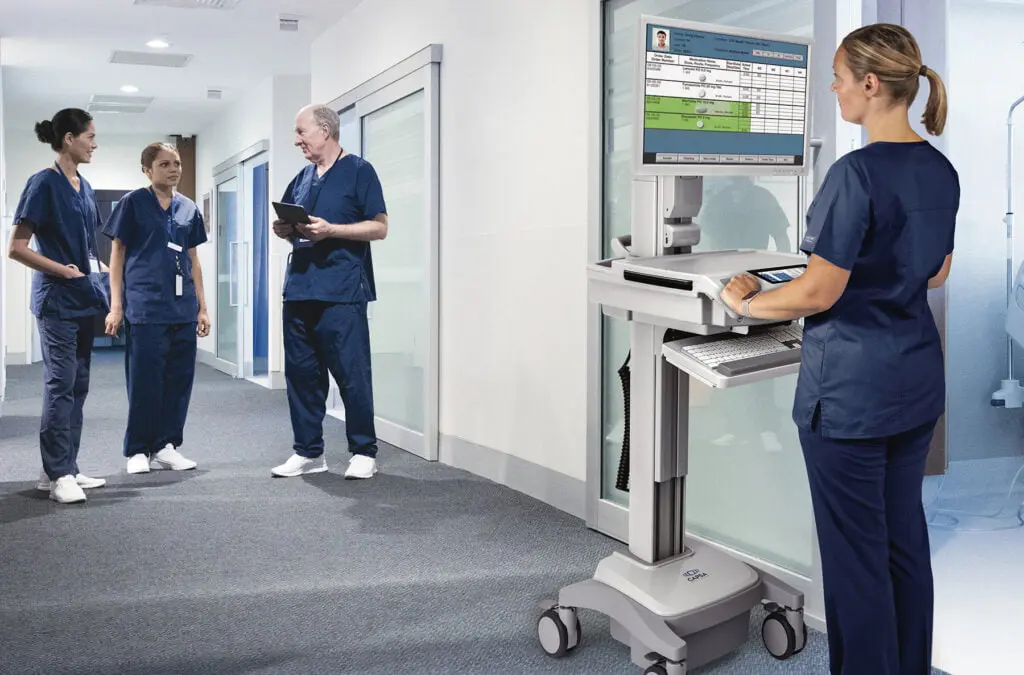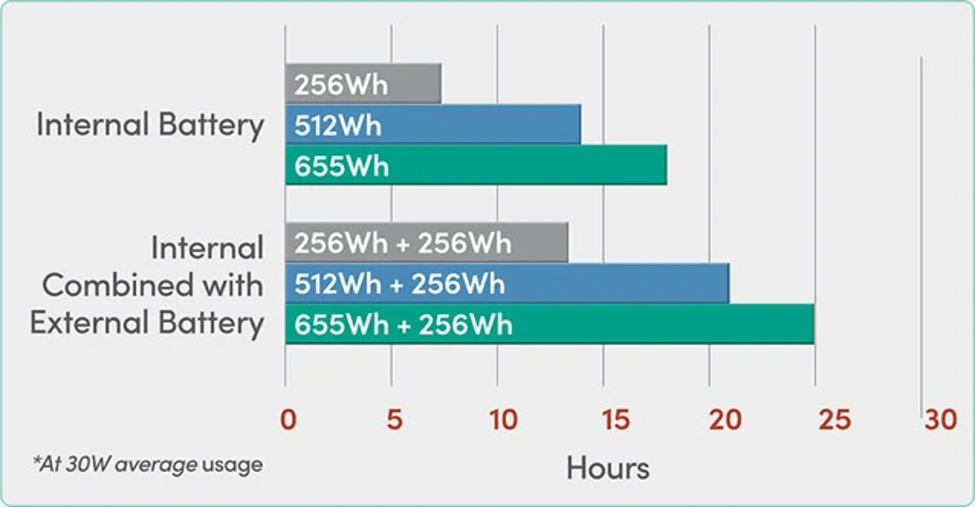
Clinicians in healthcare facilities use mobile medical carts for various purposes, such as clinical documentation, medication administration, or telehealth consultations. Each use case may require differing power needs for the cart and integrated technology. When considering your fleet’s power options, maximizing the value is crucial by selecting a power solution that aligns perfectly with your facility’s diverse runtime needs.
Ensuring an uninterrupted power supply is critical for clinician workflow and uninterrupted patient care. Having a medical cart battery run down during a procedure or a telemedicine appointment can negatively impact clinical efficiency and patient care.
Run down batteries can also lead to cart abandonment. Cart demand may increase as busy clinicians simply grab the nearest functional cart instead of waiting hours for batteries to recharge.
Trio’s GoLife Power System offers customizable solutions to fit the power needs for your computer workstation. You can choose the capacity of the in-base battery to ensure it matches your workflow demands. It’s easy for clinicians to see how much battery time remains by viewing the cart’s smart screen display.
Choosing a power option that fits your use case is easy with GoLife. You have three options available for the in-base battery:
If you need longer runtimes or have heavier power consumption, you can add GoLife’s convenient, easily accessible, column-mounted external battery. Each external battery provides 256Wh, giving you an additional 7 hours of runtime when consuming 30 watts/hour.
To determine which GoLife power option best fits your use cases, analyze the power consumption of the cart’s devices and compare them to the battery capacities of each battery option. Next, estimate charging cycles and user patterns while considering industry standards and regulations.
Runtime is the amount of time you can use a battery before recharging. The formula to calculate runtime is:

The first step is to add up the watts your devices require to function. You can find this using a watt meter, looking at the device, or reading the specifications.
Laptops or minicomputers usually consume about 65 watts per hour in performance mode, but more powerful models require up to 200 watts. A 20-inch LED or LCD monitor needs about 22 watts.
The second step is determining runtime, or how long the mobile cart will be operating without being plugged into an AC power supply.
Suppose your team operates a setup consisting of a laptop and two monitors, with the cart running continuously. In this scenario, the power consumption sums up to 65 watts for the laptop and 22 watts each for the two monitors, totaling 109 watt-hours (Wh). When you multiply this by 8 hours of runtime, you get a total of 872 Wh. It’s advisable to incorporate a buffer for added flexibility, so adding a 2-hour buffer increases your total power requirement to 1100 Wh.
The extent of cart usage significantly impacts power consumption. Despite the presence of multiple plugged-in devices and their watt-hour usage calculations, if the cart remains idle during part of a clinician’s shift rather than continuously in operation, the devices may not be actively running, thereby influencing overall power consumption.
You can extend battery life by encouraging your team to recharge whenever power levels drop below 50%. Habitually running lithium batteries to zero reduces their life.
A full-featured Trio workstation offers N-Sight fleet management, a cloud-based system that enables Hospital IT to manage and monitor Trio workstations remotely.
N-Sight helps optimize fleet deployment, ensuring carts are used efficiently to maximize uptime. It allows hospital IT to assess cart usage to match clinical demands and maintains cart availability. It also allows IT to monitor cart power and performance across facilities.
Key actions with N-Sight:

The primary method for monitoring your cart’s battery power depends on the model. For the Trio Computing Workstation, the touchscreen serves as the primary indicator, while the Trio LT Computing Workstation uses a keypad. If your cart includes an external battery, you can also check its charge level through the LED lights on the battery. Additionally, the touchscreen or keypad provides information about battery capacity, time remaining, and charge time, considering both the in-base and external batteries if applicable.
Changing and charging GoLife external batteries is effortless. Lift the battery using the top handle to replace it with a fully charged one, ensuring uninterrupted operation. To recharge empty batteries, simply place them in the wall-mounted or desktop charger; it takes less than four hours for a full charge. Understanding your clinicians’ usage patterns, especially when the mobile medical cart is unplugged during shifts, is crucial.
Trio’s GoLiFe power system is built on safe, proven technology that meets or exceeds the requirements in the guidelines for medical devices in ANSI/AAMI ES 60601-1. The GoLife lithium-iron phosphate batteries comply with IEC 62133, the international standard.
After determining your mobile medical cart’s power requirements, you can choose the platform that meets your needs and budget.
The selection of power options for your mobile medical cart should not be underestimated. It is a critical decision that can significantly influence the efficiency of clinical workflows, and ultimately the quality of patient care. By conducting a thorough evaluation of your cart’s runtime requirements, analyzing the types of devices and their battery capacities, understanding user usage patterns, and adhering to industry standards and regulations, you can make a well-informed choice that ensures efficiency.
As we have delved into the details, it becomes evident that the GoLife Power System for Trio workstations presents a diverse array of customizable solutions tailored to meet your requirements. The careful selection of appropriate GoLife options for your Trio Workstation promises to not only optimize your clinician workflow but also elevate the standard of patient care provided.